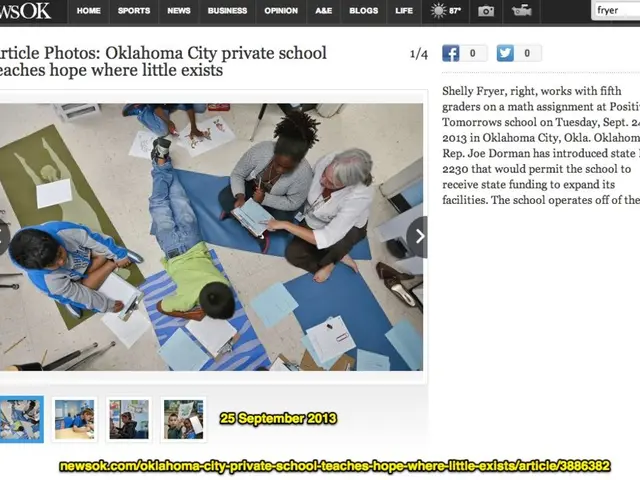Explore the Multiverse on Our Platform: Discover Our Top Picked Parallel Dimensions!
ArticlePublished January 7, 2025
Navigating the Mysteries of Star Trek's Multiverse
In the recent fifth season finale of Lower Decks, the Star Trek universehas taken viewers on a captivating journey beyond the cosmos, into the realm of multiple dimensions. The two final episodes, titled "Fissure Quest" and "The New Next Generation," delved deeper into Star Trek's multiverse, introducing parallel realities and timelines.
In "The New Next Generation," Starfleet takes a significant step, with the organization setting up a permanent outpost to explore different universes. Although the mission of Starfleet traditionally focused on the exploration of a single universe, Star Trek's expansive science fiction universe has been hinting at a larger multiverse for some time.
A Brief History of Star Trek's Parallel Dimensions
Parallel dimensions have a long and unusual history in Star Trek. The concept was already popular in 1960s science fiction, and Star Trek: The Original Series (TOS) brought the multiverse into prominence with the episode "Mirror, Mirror" in 1967. Set in the Mirror Universe, the episode influenced the sci-fi genre as a whole and is often cited by fans as the most significant multiverse story in the Star Trek universe.
Before "Mirror, Mirror," however, TOS introduced the idea of potentially destructive inter-dimensional travel in the episode "The Alternative Factor," where the crew encountered a battling pair of parallel versions of Lazarus through a strange interdimensional gateway.
Parallel Dimensions Expand Across Series
Later, in The Next Generation, alternate dimensions were depicted primarily through takes on what might have been if certain events had turned out differently. The episode "Parallels" in season 7 is particularly notable, as it depicts Worf shifting between alternate realities that initially appear only slightly different from the "normal" timeline. By the end of the episode, a rupture causes an almost infinite number of Enterprise ships to exist in the same space, creating the foundation for the Star Trek multiverse we recognize today.
Deep Space Nine focused more on the Mirror Universe once again, beginning with the 1994 episode "Crossover." Subsequent series like Voyager, Enterprise, Discovery, Picard, Prodigy, and Strange New Worlds have all explored the multiverse to varying degrees.
The Impact and Evolution of the Multiverse in Star Trek
What the last two episodes of Lower Decks have done for Star Trek is to solidify what has been brewing throughout the series. Starfleet's side quest to explore strange new realities has finally become an official mission. Although the USS Cerritos' multiverse voyage has come to an end, the human adventure in Star Trek continues, spreading across multiple timelines.
For more details on the evolution of the multiverse in Star Trek, stay tuned to Star Trek's various platforms.
** related**Why "Sarek" Still Touches Hearts, 35 Years Laterour platform: The Next GenerationThe Evolving Mirror UniverseFeatureThe Sharp Wit and Wisdom of Montgomery 'Scotty' ScottFeatureour platform's Greatest Calamitous Crash LandingsFeature
Evaluate the Enrichment Data for relevance:
The provided data offers additional background and related topics within the Star Trek multiverse, which can be referenced for further reading but should not dominate the article. Instead, this data can be integrated briefly and appropriately to enrich the reader's understanding of Star Trek's multiverse concept.
- Star Trek's expansive science fiction universe, evident in the latest Lower Decks episodes, delves into the exploration of parallel realities and timelines, an concept that has been a part of Star Trek's history since the 1967 episode "Mirror, Mirror."
- In "Parallels," an episode from The Next Generation, Worf shifts between alternate realities, ultimately leading to the foundation for the Star Trek multiverse we know today, with various series like Deep Space Nine, Voyager, Enterprise, Discovery, Picard, Prodigy, and Strange New Worlds exploring the multiverse to varying degrees.
- The Mirror Universe, which was first introduced in Star Trek: The Original Series, is not only significant within the sci-fi genre as a whole but also influenced the way parallel dimensions are portrayed in Star Trek.
- Before the focus on multiple dimensions, Star Trek: The Original Series had already hinted at inter-dimensional travel with episodes like "The Alternative Factor," where the crew encountered battling versions of Lazarus through a strange interdimensional gateway.
- As Starfleet takes a significant step by setting up a permanent outpost to explore different universes, the human adventure in Star Trek continues, spreading across multiple timelines, a mission that was subtly hinted at from the series' inception.








